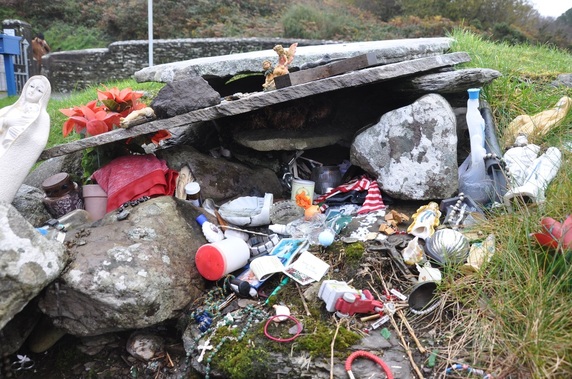 A collection of votive offerings at St Gobnait’s Well, Cork, Ireland. Photo: Richard Scriven
A collection of votive offerings at St Gobnait’s Well, Cork, Ireland. Photo: Richard Scriven Coins, shells, strips of cloth, family photos, notes, memorial cards and a host of other items are found around Irish holy wells. These collections are part devotion, commemoration and prayer. The leaving of votive offerings, as an intention or request, is an ongoing tradition at these sites. It is a practice that mixes Celtic customs, folk traditions and Catholic theology. Each of these items has a story; each of these items is a story. Part of my research is to attempt to tell the story of this practice and these objects.
Holy wells are spread across Ireland and Britain, especially in formerly Celtic lands. Some of these springs have been the site of religious-spiritual activities since the pagan era, but were adapted to Christian worship. As a result, in Ireland, these sites are currently mostly associated with the miraculous deeds of Celtic saints. Prayer rituals and religious services are held at the wells in honour of the spiritual patron linked to the site. People take away the well water for blessings, protection and supplementary medicine.
I am researching holy wells as sites of contemporary pilgrimage, where people travel to seek reflection or for a particular intention. As a geographer, I look at the importance of these places that give solace, comfort, hope and space for contemplation. The leaving of votive offerings is one of the clearest examples of how holy wells have strong meanings and powerful attachments for people. Each token represents a visit, the actions of someone whose belief brought this person here for a reason that is personally significant.
Initial fascination with these objects is replaced by speculation on their purpose. While some of the intentions appear obvious, the meanings behind other items are shrouded from everyone except the believer, and the saint or spirit of the place. This is a rich cultural practice, but it is also people’s lives. Contained in these objects are dreams, despairs, anxieties, losses and a host of deeply intimate motives.
Each item is emotionally charged telling a story in its own way. Memorial cards of departed loved ones display long lives of parents and grandparents, while those showing young people hint at tragedy. Short notes contain messages for the saints or spirits: giving thanks, calling for intercessions or just expressing feelings, which may otherwise go unarticulated. The reasons behind certain tokens are clouded, their story obscure.
Stories are embedded in objects. Monuments tell national histories, souvenirs evoke hidden memories and childhood items are kept for prosperity. My research is concerned with the stories of the offerings left at holy wells. In my writing, I tell the stories of these objects in a general sense, but I am also deeply aware that each of these objects is a story, a story I do not know and cannot tell.
Richard Scriven (@CorkGeog)
Photo Caption: A collection of votive offerings at St Gobnait’s Well, Cork, Ireland.
 RSS Feed
RSS Feed
